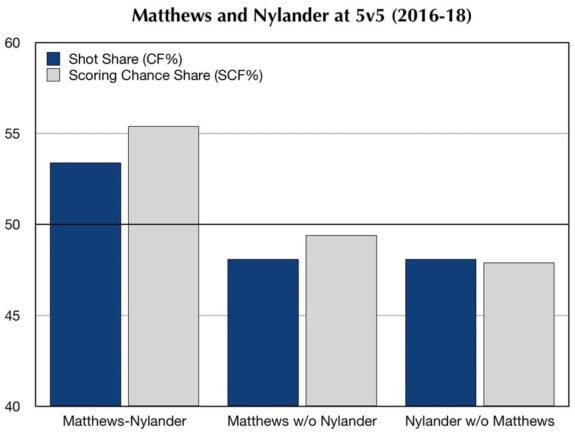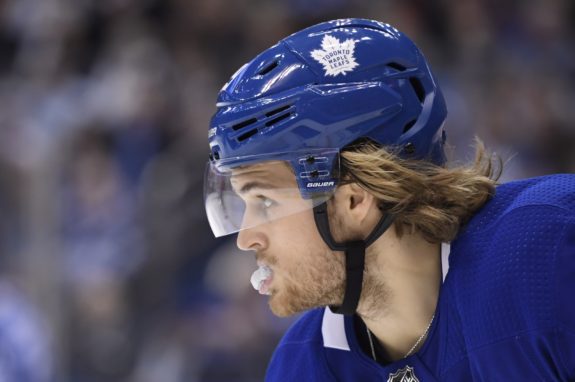William Nylander would be the first person to tell you that he had a disappointing 2018-19 campaign. After scoring 61 points in each of his first two seasons, he tallied just 27 in 54 games last year, a meager 41-point pace. Nylander’s performance looked even worse in the eyes of the public on the heels of his controversial holdout and eventual payday, which will net him $6.96 million per season over the next five years.
To be fair to the Toronto Maple Leafs’ star winger, though, most of his struggles can beexplained away quite easily. He missed training camp and the first two months of the season, and it was clear that he wasn’t in game shape until about January. On top of that, the Swede battled some extraordinarily bad puck luck as he scored on just 5.38 percent of his shots – less than half his average rate over the two seasons prior.

But enough of the excuses. It’s a new season and a fresh start for Nylander. He has a lot to prove, not only to himself, but to the entire Maple Leafs organization. And there’s plenty of reason to believe that he’s poised for a bounce-back season.
He’ll Be Reunited with Auston Matthews
It’s no secret how deadly the one-two punch of Nylander and Auston Matthews can be, but it was scarcely seen last year after the Swede joined the team late. In 2018-19, the pair played 266 minutes together at 5-on-5, just 38 percent of the Swede’s ice time on the season. Given their results together, it’s a mystery that they weren’t attached at the hip.
As per THW’s Peter Baracchini, it’s clear that both Nylander and Matthews benefit from playing with one another. Looking at the larger sample size of their first two seasons together, the results point to the same conclusion: the pair should never be separated.

5v5 shot and scoring chance share of Matthews and Nylander when they’re together vs. apart. Chart from “Tulloch: Why the Leafs should never separate Auston Matthews and William Nylander,” The Athletic, 5/23/19)
If the Maple Leafs are going to reach the next level this season, they’ll need both Matthews and Nylander to dominate together on a consistent basis. And it seems like their coach knows that too. The Maple Leafs’ forward lines are more or less set, and it looks like Nylander will play alongside Matthews and fellow swede Andreas Johnsson, at least to start the season.
The line has played two preseason games together so far, and the results have been promising to say the least. Over 28 minutes at 5-on-5, they’ve only outscored their opponents 2-1, but they’ve controlled shots and scoring chances to the tune of 71.19 and 77.42 percent respectively. While preseason play isn’t necessarily the best indicator of regular-season success given the inconsistent quality of opposition, that kind of domination should provide enough confidence and momentum to carry them into October.
He’ll Have More Help on the Power Play
One of Nylander’s biggest struggles last season came on the power play. He produced at a rate of 3.58 points per 60 minutes, registering just one goal and five assists in 100 minutes of action. That was the worst power-play performance of his career and a major fall off from his results in 2016-17, where he scored at a clip of 8.12 points per 60 minutes, the best on the Maple Leafs that season. That was the first year we saw Nylander and Matthews play together, and their chemistry was clearly off the charts.
In 2018-19, Matthews was promoted to the first unit alongside Mitch Marner, John Tavares, Nazem Kadri, and Morgan Rielly. Nylander, on the other hand, was left to play alongside less talented guys like Patrick Marleau, Tyler Ennis, and Connor Brown on the second unit. Clearly the idea was to stack the first line, which left Nylander with very little to work with on his unit.
This season, though, the Maple Leafs have had plenty of roster turnover, which means a new and improved second power play. Tyson Barrie will man the point, coming off a season where he finished sixth among defencemen in power-play scoring – four points better than Rielly. Jason Spezza will occupy one of the half-walls, where he was arguably an even better playmaker than Marner on the man advantage last season, registering a superior primary assist rate than the Maple Leafs’ winger. And Alexander Kerfoot, who scored at the exact same rate as Marner on the power play, will play the bumper role. Nylander will occupy his spot on the half-wall as one of the primary puck handlers, and it looks like new assistant coach Paul McFarland will have the Swede on his off-wing to establish a one-timer threat.
All of that adds up to what could be an underrated and sneaky good power play. Frankly, it’s probably better than most teams’ first power-play units. For that reason, expect Nylander to have a huge rebound in terms of power-play production this season.
Momentum Is on His Side
Sports are emotional. Players will tell you that confidence plays a huge role in their success. If you think you’re going to dominate, you probably will. But you only reach that belief through repeated success: you’ve got to prove to yourself that you can dominate, and then the belief becomes ingrained.
For Nylander, it’s clear that he lacked that confidence last season. He had solid underlying numbers, but he couldn’t put the puck in the net, and playing alongside guys like Marleau and Brown likely didn’t inspire much confidence either. Coming into this season, things are different.

For starters, Nylander will have a full training camp under his belt. I don’t think it can be overstated just how crucial camp is for players to get into game shape. We see time and time again that players who miss camp have slow starts and disappointing seasons.
Back in 2016, Calgary Flames forward Johnny Gaudreau signed on Oct. 10, two days before the start of the regular season. He suited up for the first game of the season, but just from missing training camp, it was clear that the shifty winger was a step behind. He finished the season with just 61 points in 72 games – a far cry from the 84 and 99 points he scored over the next two seasons, respectively.
Now compare that to Nylander who not only missed camp, but also the first two months of the regular season. He didn’t play his first game until Dec. 12 last season, so it’s no wonder that he never truly recovered.
Nylander already looks on top of his game and we’re not even into October yet. Through two preseason games, he’s generated the most shots (10), shot attempts (21), and scoring chances (13) on the team. A full camp will do wonders for his confidence, and that should lead to a hot start.
Going back even before training camp, Nylander found his swagger at the IIHF World Championships in May. He scored five goals and 18 points for Sweden in eight games to lead the tournament in points and assists, while his dominant play earned him a spot on the tournament All-Star team.
Now you can discredit or gloss over Nylander’s international results if you want, but as per Jarrett Noakes, history suggests that such a performance leads to NHL success. Over the past 30 years, only one player has equaled Nylander’s scoring rate of 2.25 points per game at the World Championships, and that was Sebastian Aho in 2018. Aho scored 65 points in 2017-18, dominated at Worlds with 18 points, and then carried that momentum into the NHL season where he exploded for 83 points.

It’s not outlandish to suggest that Nylander could see a similar level of growth. If we look at the past 10 years, the NHL’s top scorer at Worlds went on to score at an average rate of 75 points per 82 games in the following season. This gives us a pretty good ballpark estimate for Nylander, who could certainly score in the 70-80 point range this year, even without top power-play time.
Needless to say, all eyes will be on the 23-year-old as he looks to rebound from a disappointing 2018-19 campaign. There have been questions about his ability, his potential, and his salary – at times rightfully so. But fortunately for the Maple Leafs, Nylander looks poised for a bounce-back and a true breakout season. And on the heels of a sizable shift in the market this summer, we may just be talking about Nylander’s contract as a steal by the end of the season.
Player stats from https://www.hockey-reference.com/ and http://naturalstattrick.com/